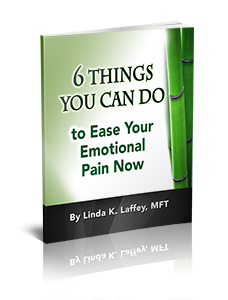If you live with chronic pain, you know on some level, that your suffering is connected to more than just physical damage, symptoms, or problems. It’s deeper than any of that. Your emotions feel inexorably tied to and woven into your pain. The way you think seems affected and complicated by it. Traumatic memories add to your stress.
It’s no wonder then, that trying to feel better has been more complicated and frustrating than you can continue to tolerate. Fortunately, recent research indicates that there are emotion-focused, psychological interventions that may be particularly effective.
Consider EMDR
For more than 30 years EMDR, or Eye Movement Desensitization and Reprocessing, has most often been used in the treatment of post-traumatic stress disorder. This treatment uses a combination of exposure combined with your own eye movements or other form of bilateral stimulation to reframe painful memories and transform feelings.
It is a unique treatment that is a far cry from talk-therapy. Verbal sharing relies heavily on retelling traumatic experiences, draining emotional expression and probing intellectual insight. All of these can amplify, upset and exacerbate emotionally-linked chronic pain.
Instead, EMDR offers some respite from such potentially harmful, repeated, intense verbal re-experiencing, which, honestly, might keep you from seeing treatment through.
EMDR has proven to decrease emotional distress and resulting pain in very unique ways. While each individual case is different and has a treatment plan that is unique to that individual, according to EMDR procedure, you might be asked to mentally recall specific cognitive and emotional events, possibly even traumatic memories, while simultaneously focusing on bilateral eye stimulation (usually therapist hand movements or tapping) repeatedly.
Why? You’ll track changes in perception each time as your eye movements are redirected from those associated with painful thoughts. This continues until the memory is adequately reprocessed. It is not the goal of EMDR to help you forget or change the facts of what happened to you. Instead, to facilitate a change in your perspective is the desirable outcome, along with a substantial reduction in the amount of pain associated with that perspective.
On the whole, EMDR is built on the premise that people have within them an innate capacity (or Adaptive Information Processing system) by which to heal and live in a state of optimal health.
What better treatment to help address stunted healing and chronic pain?
Why EMDR Should Be a Part of Your Chronic Pain Treatment
1. A growing body of scientific evidence indicates EMDR efficacy in relieving PTSD leads to clear information regarding its use in the treatment of chronic pain.
The last half decade has produced more than a dozen published research papers and studies which maintain that EMDR can help ease pain significantly. We now have reason to believe that the process taps into both the neurological and psychological processes of pain, especially and including brain regions like the amygdala, the hippocampus and the prefrontal cortex.
2. The unique bilateral stimulation component seems to be key to EMDR efficacy.
Bilateral stimulation essentially activates an evaluative system deep in the brain designed to respond to new stimuli. This system is responsible for our sense of curiosity and interest. When activated, this system works with other regions of the brain to determine whether the stimuli is a threat. Thinking of pain or anything else threatening is almost impossible.
If there is no threat, your brain relaxes. Relaxation becomes a part of the whole experience. Repeated doses of EMDR change the way pain is experienced. Awareness of pain decreases and feelings of drowsiness increase. The inability to worry and a sense of detachment occur. People note that the pain itself seems to drain out of their bodies.
3. The research indicates that EMDR can facilitate pain relief and reduce the emotional distress associated with trauma. Chronic pain represents a “small-t” trauma.
EMDR appears to help you cope. Chronic pain is often accompanied by life-changing events, relational problems and difficult transitions that are traumatic personally. After just a few minutes of EMDR, pain levels can seem to be significantly less. According to participants, by the end of about 8 sessions, negative attitudes and automatic responses toward pain shift from powerlessness or helplessness to empowerment. You gain a sense of control: of the pain, yourself, and your quality of life.
Take the first step…
If you are ready to consider EMDR Therapy in the treatment of trauma and/or chronic pain, I would like to help. I have been a Certified EMDR Therapist since 2004, have helped hundreds of clients benefit from this incredibly useful methodology, and have advanced training in using EMDR to treat chronic pain. Please get in touch with me via voicemail or email so we can discuss how we might work together to change your life for the better as quickly and effectively as possible.
I look forward to hearing from you.
Linda K. Laffey, MFT


